Spinal disorders can cause many unpleasant sensations for a person, especially if they affect the cervical region: there is a danger of damage to the spinal cord and brain. In addition, osteochondrosis of the cervical spine often causes headaches, disrupts the functioning of internal organs, and contributes to the deterioration of blood circulation. Fortunately, nowadays, several therapeutic techniques have been developed that allow to eliminate unpleasant symptoms and restore a healthy state of the spine.
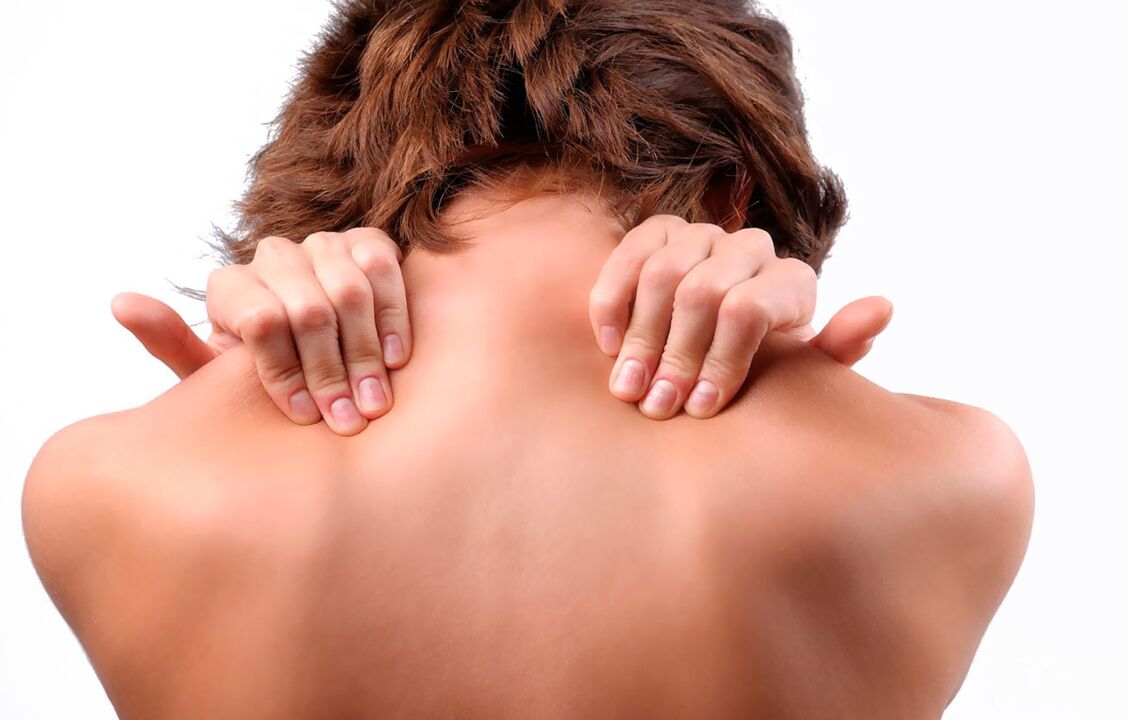
In this article, we will present in detail the characteristics of cervical osteochondrosis and describe the main methods of its treatment. We hope that after reading it you will be able to choose the most effective way to deal with this disease and avoid radical surgery.
What is cervical osteochondrosis?
<2_img_rightxx>Cervical osteochondrosis is a disease in which the soft pulp ossifies, which acts as a cushioning function between the vertebrae. At the same time, blood vessels and nerve roots are involved in the disease's development mechanism.
A characteristic of osteochondrosis of the cervical spine is the occurrence of pain in the shoulders, occipital region, neck and head. In addition, patients experience dizziness, increased blood pressure, lack of oxygen, loss of sensation on one side of the tongue, and other symptoms characteristic of cardiovascular pathologies. This becomes the reason for contact with physicians from other specialties and significantly delays the process of diagnosing the disease.
Most of the time, people in the middle and old age categories are prone to ossification of tissues in the upper part of the spine. This is due to the incorrect distribution of dynamic and static loads in the human skeleton.
However, if previously cervical osteochondrosis and itssymptomshave been diagnosed in people over 45-50 years old, but now the age of patients suffering from this disease is significantly younger. Today it affects young people aged 20 to 40 years, which is associated with a deterioration in diet and sedentary lifestyle.
Currently, there is a dual approach to the problem of the cervical spine: it is considered to be a combination of physiological and pathological factors. In the first case, we are talking about the aging of the body under the influence of unavoidable natural phenomena; in the second, it is assumed that the destruction of intervertebral formations occurs in the context of inflammatory and dystrophic processes caused by an inadequate lifestyle.
Osteochondrosis symptoms of the cervical spine
Problems with diagnosing this illness are due to the absence of pain in some situations and the underlying nature of the symptoms. Also, a person may not feel the signs of illness by regularly taking strong pain relievers to minimize general discomfort. All of this can lead to serious disorders in the area of the cervical joints.
Among the obvious symptoms of cervical osteochondrosis, causing the need fortreatment,include: headache, high blood pressure, frequent dizziness. We'll talk more about them.
Dizziness with cervical osteochondrosis

Dizziness does not always manifest itself in the context of cervical spine problems. In some cases, it indicates brain disorders, malfunction of blood vessels and the heart, inflammatory processes in the ear and nasopharynx, the presence of malignant neoplasms or any pathological conditions of the nervous system.
Dizziness with cervical osteochondrosis and the need for its treatment may have a non-systemic or systemic etiology.
In the first case, a person may have a feeling of lightheadedness, uncertainty while standing, and some fainting. At the same time, there is no sensation of circular rotation.
On the other hand, systemic dizziness, then, most of the time, is an indication of some vestibular disorder, malfunction of visual analyzers and other changes that emerged in the context of osteochondrosis. In this case, the patient can feel the circular rotation of the body or nearby objects.
If dizziness is present and the patient simultaneously develops symptoms such as acute pain in the head, numbness in the upper chest, fainting, or difficulty coordinating movements, he should be hospitalized urgently.
Headache with osteochondrosis of the cervical spine
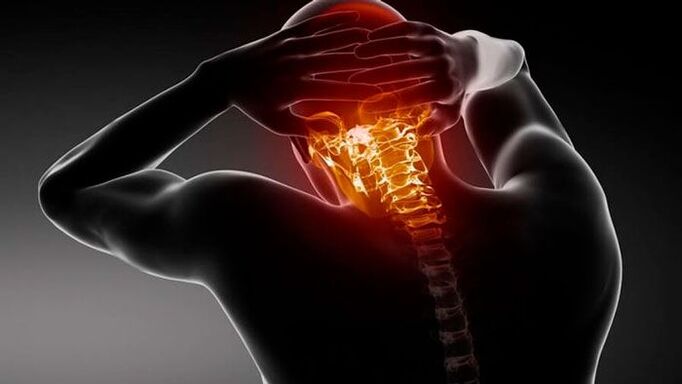
The appearance of a headache can indicate the presence of a wide variety of illnesses. It most often occurs in women in the context of hormonal disturbances, stressful situations, increased intracranial pressure, brain spasms, compressed nerve endings, inflammatory processes, and other illnesses.
can signal the presence of a wide variety of diseases. It most often occurs in women in the context of hormonal disturbances, stressful situations, increased intracranial pressure, brain spasms, compressed nerve endings, inflammatory processes, and other illnesses.
pain andnoise in the headwith cervical osteochondrosis, causing the need for treatment, is often confused with symptoms of acute disturbance of the blood supply to the brain, high blood pressure or coronary heart disease. Most of the time, these signs occur in elderly people who suffer from the above illnesses.
To determine the exact cause of headaches, you should consult an experienced specialist. In this case, it is recommended to perform an ECG and exclude the presence of cardiovascular disorders.
Pain from another location, characteristic of cervical osteochondrosis

Pain in the back of the neck and head is not always a sign of cervical osteochondrosis. In some cases, discomfort can spread from the neck to the arms and shoulders. These symptoms are sudden in nature and can occur in the context of sudden movements, after a heavy sneeze, or staying in the same position during a night's sleep.
If the cause of the pain syndrome is chondrosis of the cervical spine, it usually disappears after a certain time or disappears after manual therapy on the cervical spine.
It should be noted that massage in this area is only performed after a thorough examination of the patient. With an unprofessional approach, there is a high risk of worsening the patient's condition, including his disability.
If we are talking about osteochondrosis of the cervical spine and the need for its treatment, patients notice the following sensations of pain:
- The appearance of a crunch during head rotation;
- The presence of pain syndrome inside the neck;
- Deterioration of sensitivity and appearance of muscle weakness in various areas of the body.
Increased blood pressure with cervical spine problems

Since the cervical vertebrae are directly connected to blood vessels and nerve endings, any rupture in this area can cause an increase in blood pressure. However, these jumps are temporary in nature, manifest as short-lived spasms, and are not symptoms of hypertension.
In addition, if there is osteochondrosis of the cervical spine, in addition to increased pressure, the patient may have other symptoms, and treatment in this case includes the use of special anesthetics. These include:
- The appearance of pain in the head region;
- Loss of sensation on the collar;
- Pain in chest, arms and legs;
- Marked increase in blood pressure after stressful situations, prolonged stay in one position, excessive muscle tension, and other similar situations.
A strong deterioration in the patient's condition and a marked increase in pressure indicate an urgent need to see a doctor.
Stages of development of cervical osteochondrosis
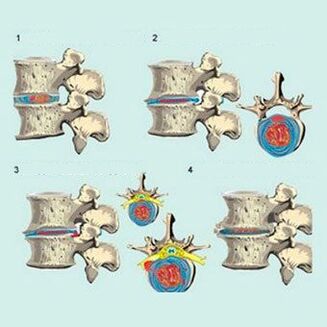
As it develops, the above disease goes through several stages, accompanied by specific symptoms. We'll talk about them in more detail below.
Early stage osteochondrosis
As a rule, if the first degree of illness occurs, patients may experience only mild discomfort. They can show pain only with sudden movements, tilting and turning their head. Many patients report increased fatigue in the lumbar spine and back, and a constant feeling of tension. The treatment of osteochondrosis of the cervical spine at an early stage does not involve takingdrugs. . . To recover, the patient only needs to performfitnesswith cervical osteochondrosis and change the daily diet.
The second stage of the disease: characteristics
The second stage of the pathology is characterized by more intense pain sensations that radiate to the upper extremities and increase with flexion and rotation of the head. Reasons for the increased discomfort include: a reduction in the height of the intervertebral discs and, as a result, pinching of the nerve endings. In this case, the patient notices deterioration in work capacity, appearance of distraction, increased fatigue and headaches.
Third degree osteochondrosis
It is accompanied by an increase in pain radiating to the upper extremity area as well as the shoulders and neck. In this case, numbness in the muscles of the hands can be observed, which is associated with the appearance of an intervertebral hernia. In addition, patients may complain of severe weakness and dizziness.
The last stage of the disease

In the final stage, deep degenerative processes in the area of the intervertebral discs and their replacement by pathological tissue make themselves felt. The need for treatment of cervical osteochondrosisin the exacerbation stageit may be due to the defeat of several segments of the spine. In this case, patients report the presence of tinnitus, increased pain syndrome, appearance of intense dizziness and difficulty in coordinating movements.
Causes of cervical osteochondrosis
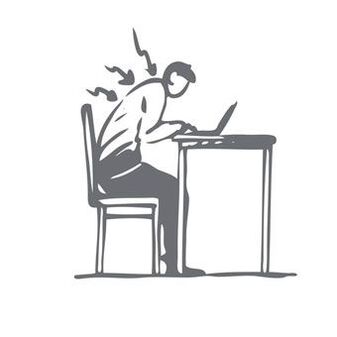
Most of the time, the development of this pathology is due to the daily sedentary work, in which the person does not control the correct position of the body in the chair and his head is constantly tilted forward. The same can be said about the prolonged permanence of the head tipped back, typical of construction specialty workers, when carrying out repair activities.
As a rule, excessive stress on the cervical spine inevitably leads to degenerative disorders in the area of the vertebral discs. In addition, cervical-vertebral osteochondrosis, the symptoms of this disease and the need for its treatment may be due to the following factors:
- Violation of calcium metabolism;
- Causes of a genetic nature;
- Thermal irritants;
- In the practice of extreme sports (treatment of sports injuries);
- Hypodynamics;
- Long stay of person in office due to professional affiliation;
- Obesity;
- Prolonged stress situations;
- Neck and neck injuries;
- Autoimmune processes that can lead to cartilage tissue destruction.
Transitioning to a healthy diet and moderate physical activity can minimize the likelihood of developing osteochondrosis.
Syndromes in cervical osteochondrosis
Syndromes are represented by the simultaneous manifestation of several symptoms of the disease at the same time. Osteochondrosis of the cervical spine is characterized by the following syndromes: vertebral, vertebral, cardiac and radicular arteries. It is about them that will be discussed below.
What is Spinal Syndrome?
<10_img_rightxx>In the presence of the above syndrome, degenerative processes directly affect cartilage and bone tissue. In this case, the simultaneous manifestation of the following three signs is observed:
- Painful sensations when it is necessary to turn the neck;
- Inability to rotate the neck;
- The presence of a disturbance in the intervertebral region or in the vertebral body, of a morphological nature (to determine this symptom, radiographs are taken).
If the patient does not have at least one of the above signs, it makes no sense to talk about vertebral syndrome.
Features of vertebral artery syndrome
The essence of the above syndrome is damage to the vertebral arteries that supply blood to the brain. It is characterized by the simultaneous manifestation of the following symptoms:
- In the context of artery compression, the patient may experience dizziness, increased blood pressure, tinnitus, nausea, etc. . ;
- Due to irritation of the nerve roots, loss of sensation, appearance of "flies" in the eyes, acute pain in the head and numbness can be observed;
- Lack of oxygen can cause severe pain in the head region, excessive sleepiness, decreased activity and decreased concentration.
Signs of heart syndrome
In addition to the vertebral artery symptom in cervical osteochondrosis, the patient's need for treatment also arises in the presence of cardiac syndrome. Many patients report a condition that is characteristic of coronary heart disease or resembles the symptoms of myocardial infarction. In this case, the following signs occur:
- Burning sensation and acute pain syndrome in the sternum area;
- Tachycardia;
- The appearance of severe weakness, excessive fatigue and shortness of breath.
Root syndrome: characteristics
<12_img_rightxx>It is characterized by a deterioration in neuromuscular conduction. In the presence of radicular syndrome, the patient may experience loss of sensation or, conversely, severe pain syndrome. In addition, its features include:
- Pain in the back of the head or, conversely, numbness in that area;
- Difficulty chewing food, numbness in the area behind the ear, feeling of fullness on the tongue;
- The appearance of symptoms of sore throat, hiccups, pain in the collarbone;
- Difficulty in moving the upper limbs, discomfort in the shoulder region;
- Violations in the area of the forearm and shoulder blades;
- Loss of sensation in the area of the fingers.
Diagnosis
<13_img_rightxx>The main and most informative methods for diagnosing osteochondrosis include magnetic resonance imaging (MRI). Highly detailed MRI scans reflect the state not only of the bone tissue of the spine, but also of the soft tissue - muscles, cartilage, blood vessels, nerves and intervertebral discs. If there are contraindications to MRI (presence of metallic prostheses, pacemaker), computed tomography is prescribed, but the informative content of the method is much lower for the diagnosis of osteochondrosis.
Is it possible to treat osteochondrosis of the cervical spine?
When it comes to cervical osteochondrosis, effective treatment of this disease is only possible with a comprehensive lifestyle review, constant prevention, and healing recovery. In practice, few manage this, especially in the climate of our country, when it is almost impossible to completely avoid hypothermia and new inflammatory processes. However, you can significantly alleviate your condition, even in more advanced cases, and prolong periods of remission.
Treatment of cervical osteochondrosis
<14_img_rightxx>In the first stage of osteochondrosis, the patient will be helped by conservative treatment without medication. You must correct your posture, pay attention to the equipment in the workplace, take a break from work for a few minutes every day to do an uncomplicated job.corrective gymnasticswith cervical osteochondrosis, which can be done directly on the office table. Swimming, increased physical activity, and intake of vitamin and mineral complexes will have a positive effect on the entire musculoskeletal system.
Benefits of shockwave therapy
If the patient has osteochondrosis of the cervical spine and its symptoms, a new method of treatment is considered the most effective - with the aid of shock waves. This procedure is notable for its affordable cost. Also, if a medical institution has special equipment, you can take the UHT course completely free of charge.
<15_img_rightxx>UHT advantages include:
- Maximum efficiency;
- Absence of discomfort during the procedure;
- The minimal probability of side effects;
- Reducing the need for invasive treatments
- Reducing the need to take medications.
Drug for cervical osteochondrosis
If you have cervical osteochondrosis and are interested in treatmentmedicinalandeffective,you can find information about suitable medications on the Internet. However, despite the variety of medications and the lack of need for a prescription, self-medication is not recommended. Most medications have side effects and contraindications, it is also important not to overdose.
Non-steroidal anti-inflammatory drugs (NSAIDs).They are used to relieve swelling and pain.
Muscle relaxants, sedatives
They are additionally prescribed to alleviate the patient's general condition and reduce the dose of NSAIDs. By simultaneously relieving muscle spasms and nervous tension, you can get the best therapeutic effect.
At the end of treatment, doctors often recommend purchasing nonsteroidal anti-inflammatory drugs for the first-aid kit, as neck pain can return when the weather changes, overexertion, and stress.
Physiotherapy Approaches
In cases where drug therapy is contraindicated or does not have the desired effect, and sometimes with a complex effect, physical therapy methods, available in both classical and alternative medicine, are used. They are all aimed at relieving muscle spasms, inflammation and pain.
Acupuncture. The essence of the method is to "awake" biologically active points by inserting special fine needles into them at a depth of several centimeters. The procedure is painful in itself, but it helps to relieve back pain. Multiple sessions are required.

Manual therapy. This method is effective if the patient haspinchcervical spine nerves, the corresponding symptoms were diagnosed and the need for treatment identified. Nerves and blood vessels trapped by deformed vertebrae can be released by manually stretching the spine.
Hirudotherapy (leeches). Relieves inflammation and swelling due to biologically active substances that are secreted by leeches. Strengthens blood circulation.
Shockwave therapy. Restores blood circulation and destroys osteophytes, helps cartilage tissue return to its normal structure. The patient already after 1-2 sessions feels a decrease in pain and swelling. The course of shockwave therapy includes up to ten procedures and can be prescribed as part of complex non-invasive therapy and during the rehabilitation period after surgery. It has a number of contraindications and is used only after a comprehensive examination by a variety of specialists, including a neurologist, cardiologist and vertebrologist.
Exercises for cervical osteochondrosis
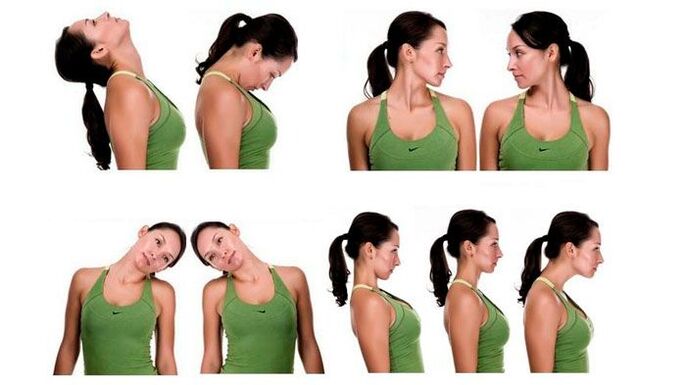
If a person has cervical osteochondrosis, dailyExercises,developed for the treatment of this disease, it will help to strengthen the muscular corset, which means - to reduce the load on the cervical spine. Physical therapy is indicated for all stages of the disease, in addition to being a preventive measure. During exacerbations, a series of exercises should be performed with caution.
Typical exercises for the treatment of osteochondrosis of the cervical spine:
- head turns sideways;
- head tilted back and forth;
- lift your shoulders with your hands relaxed or fixed, holding them in this position for 15 to 20 seconds;
- alternating tension of the neck flexors and extensors with a stationary head position.
Exercises should be repeated 5 to 7 times. Lesson duration is 15 to 20 minutes.
Surgical intervention
In the absence of a positive effect after 6 months of conservative treatment, spinal fusion may be indicated. The procedure aims to immobilize the affected vertebral segment. It includes removing the intervertebral disc, decompressing the nerve root, and placing an implant or creating a physiological height of the disc space. The operation has many contraindications and side effects. For example, spinal fusion can lead to spinal deficiency. Therefore, surgical intervention is indicated only in extreme cases.
nutrition and lifestyle
<18_img_rightxx>After surgical treatment of cervical osteochondrosis, in the initial period of rehabilitation, it is necessary to use a fixation collar. During conservative treatment and in the late rehabilitation period, it is recommended a diet rich in calcium and vitamins, correction of usual postures and postures in general, daily set of therapeutic exercises for the neck, orthopedic pillows.
Treatment of Cervical Osteochondrosis at Home
If you have been diagnosed with cervical osteochondrosis and its symptoms, and you wish to undergohome treatment,it should be remembered that such independent intervention can only be practiced in combination with procedures prescribed by a specialist.
Some experts recommend usingorthopedic pillowwith cervical osteochondrosis and use heating agents such as pepper plaster, mustard plaster, and alcohol swabs. According to others, just specialExercisesfor treatment andprevention. . .
You can also turn to traditional medicine recipes, which are based on the use of honey potato compresses and dressings with natural ingredients. More information about these tools can be found on the Internet. However, only an experienced and highly qualified physician can diagnose cervicothoracic osteochondrosis, identify its symptoms, and prescribe the most effective treatment.
Preventive measures for cervical osteochondrosis

An examination by the attending physician is required once a year. A course of shockwave therapy may be prescribed. Hypothermia and infectious diseases, prolonged computer work in one position should be avoided. If you're traveling on a long plane or bus, use a neck support pillow to help relieve muscle tension and prevent congestion. For daily sleep, use special orthopedic pillows that ensure correct head positioning.

















































